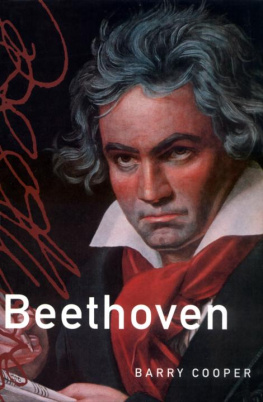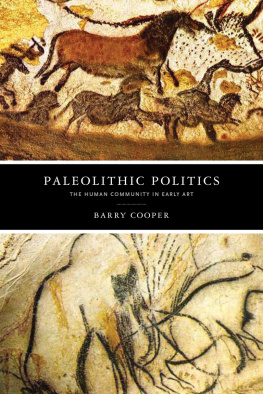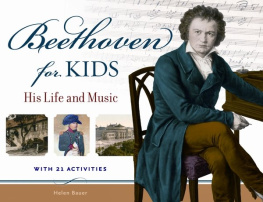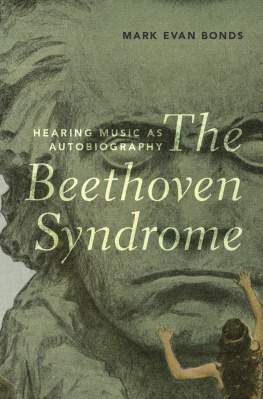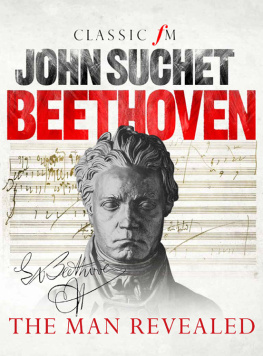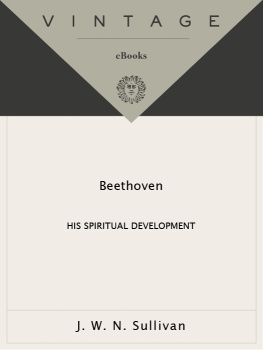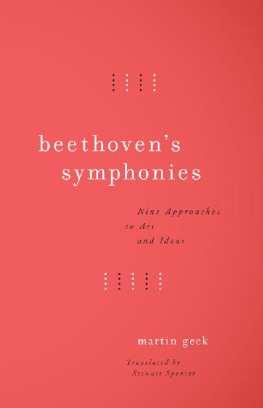THE MASTER MUSICIANS
BEETHOVEN
Series edited by Stanley Sadie
The Master Musicians
Titles available in paperback
Bach Malcolm Boyd
Bartok Paul Griffiths
Berlioz Hugh Macdonald
Brahms Malcolm MacDonald
Britten Michael Kennedy
Bruckner Derek Watson
Chopin Jim Samson
Grieg John Horton
Handel Donald Burrows
Liszt Derek Watson
Mahler Michael Kennedy
Mendelssohn Philip Radcliffe
Monteverdi Denis Arnold
Titles available in hardback
Beethoven Barry Cooper
Chopin Jim Samson
Elgar Robert Anderson
Handel Donald Burrows
Liszt Derek Watson
In preparation
Dvorak Jan Smaczny
Musorgsky David Brown
Purcell J. A. Westrup
Rachmaninoff Geoffrey Norris
Rossini Richard Osborne
Schoenberg Malcolm MacDonald
Schubert John Reed
Sibelius Robert Layton
Richard Strauss Michael Kennedy
Tchaikovsky Edward Garden
Vaughan Williams James Day
Verdi Julian Budden
Vivaldi Michael Talbot
Wagner Barry Millington
Schubert John Reed
Schutz Basil Smallman
Richard Strauss Michael Kennedy
Stravinsky Paul Griffiths
Puccini Julian Budden
Schumann Eric Frederick Jensen
THE MASTER MUSICIANS
BEETHOVEN
Barry Cooper





For Hugh, Paul, Rachel, and Simon
Preface
Such an approach is particularly advantageous in the case of Beethoven, since most of his life was devoted to his works and centred around them. It might even be said that his composing life was his real life, the true home for his mind, and the embodiment of his spiritual development, whereas mundane activities of daily life were of marginal concern for him.
far more is known now than as little as twenty years ago about this aspect of his life, and in any balanced biography his sketches and autograph scores should occupy a prominent place. The sketches pose a particular problem for a life-and-works study, since there has been much debate about whether they are primarily of biographical or analytical significance. In fact, they shed much light on both his life and his works, bridging the gap between them. For instance, when it is noted that Beethoven added the first bar of the slow movement of the `Hammerklavier' Sonata at a very late stage, thereby forging both a link from the end of the previous movement and also subtle motivic connections (rising 3rd followed by falling 3rd) with the first two movements, the observation is both biographical and analytical.
These two authors, however, concentrate mainly on the works. The present study, while placing more emphasis on biography, stresses those aspects of Beethoven's life that impinge most closely on his musical output. The aim has been to bring music and biography as close together as possible, so as to reveal the interconnections between the two more fully than in previous biographies.
And, even since work on the present book was begun, new editions of many of Beethoven's works have appeared, with detailed critical commentaries and background information, as part of the Beethovenhaus's Complete Edition currently in progress; a new English translation of letters to Beethoven has been issued by Theodore Albrecht; and the long-awaited Beethovenhaus edition of his complete known correspondence has finally appeared. It will be some years before all this material is thoroughly correlated and absorbed into a new picture of Beethoven, and the present book is therefore in some ways only a provisional assessment, unable to take full account of these new publications.
The information that emanated from the enormous number of slightly earlier studies-those from the 1970s and 1980s-has intensified the problem of what to omit from a single-volume general study of Beethoven. Selecting material for inclusion or omission is perhaps the most difficult decision facing the writer of such a book, and it surfaced repeatedly in the present volume. The general principle of placing emphasis on the interface between life and work has been modified by several other considerations, including the aim of including all material of exceptional significance, and a disproportionate amount of material that has not previously received due attention. This approach has also been applied to the music itself: instead of a routine and systematic summary of each work discussed, only some of its most important features and innovations are outlined, along with subtleties that have been largely overlooked.
which includes much postThayer material. Thayer's work has formed the foundation for all subsequent biographies including the present one, and where no source of information is provided here for biographical details, they generally derive from Thayer-Forbes. Much other material has also been incorporated, however, necessitating more footnotes than is usual in a Master Musicians book. Moreover, not everything found in Thayer-Forbes is reliable. Much of it is based on recollections and memoirs by a number of individuals of greatly varying degrees of trustworthiness. Chief scoundrel is Anton Schindler, an associate of Beethoven's during the 1820s and an early biographer. Schindler related a large number of stories about Beethoven and his music, but most have proved to he either completely or partly false. He even inserted numerous entries in Beethoven's conversation books after the composer's death, in order to enhance his own reputation; these entries, some of which were presented as genuine in Thayer-Forbes, were identified as fabrications only in the 1970s. Thus anything reported by Schindler must be assumed to be doubtful or false, unless supported by independent evidence (in which case, Schindler's contribution is redundant). This is especially true of his numerous anecdotes about the meaning of Beethoven's music. There is no evidence that Beethoven ever passed on to him any special insights on this subject, and wherever it has been possible to test Schindler's veracity on the matter, it has been shown to be false. Schindler's apparently fictional stories are among the most widely circulated about Beethoven's music: the claim that the opening of the Fifth Symphony denotes Fate knocking at the door; that the Sonata, Op. 31 No. 2, has some connection with Shakespeare's The Tempest; that the Triple Concerto was composed for Archduke Rudolph; that the slow movement of the Pastoral Symphony was written near Heiligenstadt and contains a fourth bird-call; and that the second movement of the Eighth Symphony was based on a canon in honour of Johann Maelzel's metronome (Schindler even composed the canon in question!).

